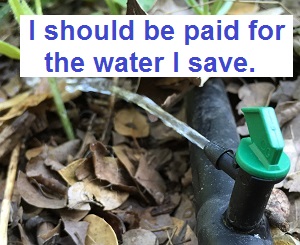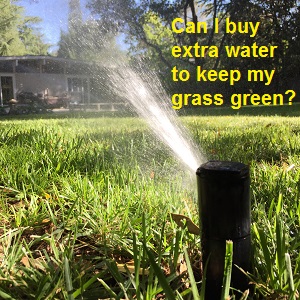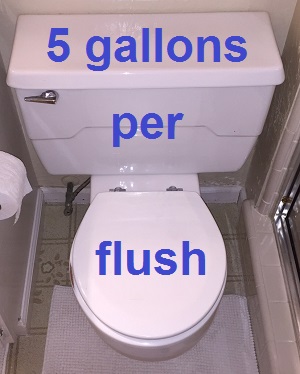
What is a homeowner’s incentive to conserve water when farmers make money selling their water?
With Governor Brown’s declarations of a drought emergency in 2014 and subsequent State Water Resources Control Board’s (SWRCB) decisions that some water districts must conserve up 36% of their consumption over the baseline 2013 year, many homeowners are wondering how they can conserve enough water without killing their entire landscaping. While some homeowners have voluntarily let their turf grass die, there are parks, schools, green belts, golf courses and businesses that are still keeping the landscapes lush and green as of April 2015. The current drought and new consumption targets have created a unique opportunity for larger water consumers to purchase unused water from property owners whose average water use is far below the target rate through a residential water market.
Residential water markets could increase conservation
The 21st century metric for measuring a community’s water conservation is the average daily water consumption per resident in gallons per day. Essentially, under the SWRCB rules, all the potable water delivered to consumers within a water district for a month is reduced to a daily average and then divided by the number of residents in the water district. This yields the average gallons per person per day (gppd) consumption. Water districts are under orders from the SWRCB to find a way to make their residential customers consume no more than a target gppd or face really big fines.
Targeted gallons per person per day
The treated or potable water totals reported by each water district not only includes single family homes but also multi-family residences with large turf areas and rural properties which may include live stock or small farming operations. So even though the figure is reported as a daily amount per resident, the numbers can be skewed significantly depending upon the types and number of water consumers in the district. Some teenagers, through taking two or three showers a day, can use more water than a milk cow.
Dang, turf grass uses lots of water

Granite Bay must reduce water consumption from 484 to 310 gallons per person per day in 2015.
The Sacramento Bee has published on online interactive map that lists all the urban water districts or utilities, their 2013 residential per gallon per day consumption, and the new SWRCB 2015 conservation goal they must reach. In my community of Granite Bay we are served by the San Juan Water District. My community in the San Juan Water District used an average of 484 gallons per person per day (gppd) during the summer of 2013. Under the new SWRCB rules Granite Bay residents must conserve 36% of the 2013 average in 2015. That means cutting consumption by 174 gppd down to an average of 310 gppd.
Granite Bay’s lush carpets of green grass
Granite Bay is an older community next to Folsom Lake with a population of approximately 21,000 residents. (Folsom Lake is the primary source of water for the San Juan Water District). Residential lots sizes of .5 to 1 acre are not uncommon and there are many properties with lots greater than an acre. Granite Bay was developed when water was cheap, plentiful, and large carpets of lush green grass were desirable.
Who will sell me extra water to keep my grass green?
In the summer of 2013, according to my San Juan Water District water bill, our residence used 458 gppd. We have three people in the household and lot size of approximately 1/3 of an acre. In 2013, less than have of the lot was in turf grass, but it was still a sizeable amount. For comparison purposes, our three person household used 68 gppd during the December 2014 and January 2015 winter months. If I want to keep irrigating the way I did in 2013, I need to either reduce my water consumption by 148 gppd (458 – 310 = 148) or I have to buy additional water.

Some Granite Bay residences will pay extra for enough water to keep their lawns green. A residential water market might help facilitate that transfer.
We need a residential market place for water sales
But how am I to get the extra water and still meet the new water conservation target for the San Juan Water District of 310 gppd? Maybe I can buy water from my neighbor that they don’t use. We are told that the best way to distribute scarce resources is through a market based system. Water markets have long been advocated for in California. If we can have a water market for big agricultural irrigation districts like Westlands Water District and large urban wholesalers such as Metropolitan Water District, why can’t we have a water market for residential consumers?
No more punitive tiered water rate structures
If my Granite Bay neighbor is only using 200 gppd during the summer months, he is under the San Juan Water District 36% conservation goal of 310 gppd by 110 gppd. With a residential water market I could purchase those 110 gppd from him to meet the 458 gppd I need to keep my landscape green. Our current rate structure in my water district really has no conservation element. With the recent court ruling that public water districts can’t charge more than the cost of the product and delivery, there will never be a price incentive to conserve water.
Elected officials don’t want to fine their voters
There is the prospect of receiving a water fine for excess usage that will make residential customers conserve water. But since most water districts have elected Board members, it is unlikely they will move to punish consumers and, more importantly, voters. A residential water market, in a sense, creates a tiered rate structure. If you want to use more water than your allotment a consumer would have to go out and purchase extra water. The homeowner not only has to pay the metered rate for the water above their conservation target, they have to pay their neighbor a premium per unit to use it.
Water is cheap compared to the commission on a million dollar home

My 1968 wall mounted toilet uses five gallons per flush, but they are expensive to replace.
In Granite Bay, where the homes can easily sell for $1 million plus, there is a greater probability of homeowners who will want to preserve their landscaping and will pay for extra water- especially if they are trying to sell their home. A water market that actually pays people to conserve water so they can sell it to larger water users may have a greater conservation effect than punitive rates and fines. Heck, if the market were strong enough with a high enough price per gallon I might let all my grass die just so I can sell the water. The money I earn from selling part of my water allotment might pay for new water efficient landscaping or to replace that wall mount toilet that uses five gallons per flush.
I want to sell my water to the highest bidder
The water market doesn’t have to be restricted to between residential consumers. Even though agriculture, industry, and business like golf course aren’t impacted by the daily gallons per person day conservation goal, they may have to abide by other water restrictions. How much would Granite Bay Golf Club pay for extra water to keep their course green? If they could purchase unused residential water allotments they might be able to acquire enough water to add an irrigation day. Companies like Nestle water bottling plant in Sacramento, Budweiser in Fairfield, or even a local coffee shop could buy residential water allotments to keep their businesses running.
People will conserve water for cash
We hear the stories of farmers selling their water to Bay Area utilities or Southern California water districts and making enough money to forego farming for a season. Why can’t homeowners be allowed to make a little extra money from their conservation efforts? We already have established markets for pollution credits, electricity and stocks. There is no reason why we couldn’t set up a state-wide market for residential water so homeowners who go the extra mile to conserve will be rewarded monetarily.


